Umbrian Inscriptions before the Roman Conquest
Key to Ancient Umbria: Home Site Map: Umbrians
Umbria before the Roman Conquest
Umbrian Inscriptions before 310/9 BC Goddess Cupra in Umbria and Picenum


Umbrian Inscriptions before the Roman Conquest
Key to Ancient Umbria: Home Site Map: Umbrians
Umbria before the Roman Conquest
Umbrian Inscriptions before 310/9 BC Goddess Cupra in Umbria and Picenum
Introduction
The first six sections below describe the surviving inscriptions in the Umbrian language that pre-date (or probable pre-date) the Roman conquest. The seventh describes the Iguvine Tables: these are by far the longest surviving inscriptions in a Sabellic language and, although they were inscribed after the conquest, they relate to the political and religious life of Iguvium in the pre-Roman period.
The numbers in square brackets in the section headings refer to the entries in the valuable catalogue of the exhibition ‘Screhto Est’, edited by L. Agostiniani et al. (referenced below).
Tuder
So-called Mars of Todi (late 5th century BC) [18]
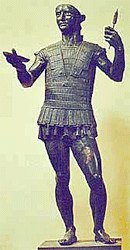
This image and the detail below are
courtesy of Dr Rozmeri Basic
This bronze, nearly life-sized figure of a warrior (which weighs about 90 kg) was found in 1835 in a travertine-lined grave at Montesanto, on the outskirts of Todi and seems to have been ritually buried after it had been struck by lightening. The Commune of Todi sold the statue to its Papal Governor in 1836, and it is now in the Museo Gregoriano, Vatican, Rome.
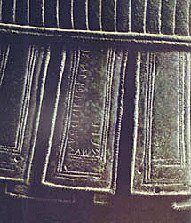
ahal trutitis dunum dede
This records the donation of some kind, probably to a God, by a man called Ahal Trutitis, who (judging by his name) was probably of Gallic descent. (It is interesting to note that a bilingual Latin/Gallic inscription (late 2nd century BC) was found at nearby Vicus Martis Tudertium (Massa Martana)).
Modern scholars reject the identification of this statue as a statue of Mars: it almost certainly represents Ahal Trutitis himself, who once leaned on a lance (of which only the upper fragment survives) and seems to have been pouring a libation from a patera. Jeffrey Becker, in the website of the Khan Academy, observed that:
“The careful burial of this object ... accounts for its survival. The composition represents the tradition of libations made by soldiers prior to battle, an opportunity for beseeching the gods for support and success in battle. “
Inscribed plates (4th century BC) [55-6]
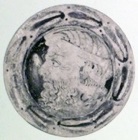
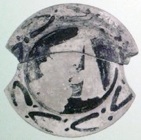
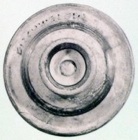
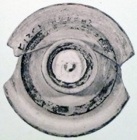
These two plates, which were found in Tomb 1 of the Peschiera necropolis of Tuder, were probably made in Volsinii (Orvieto). They depict (respectively) Charun and Vanth. The plates are now in Museo Villa Giulia, Rome.
The almost identical inscriptions on their under-sides of the plates, which use an Etruscan alphabet, read:
viscamerens
This is probably the name of the potter: the Museo Archeologico, Amelia (which is the source of the illustrations above) transcribes it as Viscus Amerinus, and the associated commentary remarks that:
“Though this craftsman worked in [Volsinii], he proudly asserted his provenance by combining his name with that of his birthplace, Ameria”
Plestia
Bronze plaques (4th century BC) [19-22]


cupr ... ...as matres p ...
Museo Archeologico Nazionale di Umbria, Perugia Museo Archeologico di Colfiorito, Colfiorito
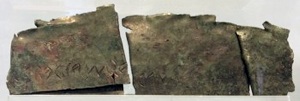
...as matres pletinas sacru esu
Museo Archeologico di Colfiorito, Colfiorito

cupras, matres pletinas sacru ...
Museo Archeologico Nazionale di Umbria, Perugia
These four fragmentary bronze foils, which were discovered in the 1960s on the site of a sanctuary near the church of Santa Maria di Plestia on the outskirts of modern Colfiorito, carry inscriptions relating to the presiding deity of the sanctuary, Cupra:
✴two of them are exhibited in the Museo Archeologico, Perugia; and
✴the other two are in the Museo Archeologico Colfiorito.
The inscriptions are in the Umbrian language, using an Etruscan alphabet that shows the influence of Volsinii (Orvieto). Only the upper three of the fragmentary inscriptions illustrated above were initially published, because the fourth had been folded into four with the inscription hidden from view. However, the forth was separated into into component parts in 1990. However, the forth was separated into into component parts in 1990. At this point, it became possible to confirm the completion of all of the inscriptions to read:
cupras, matres pletinas, sacru esu
I am a sacred to Cupra, mother of the Plestini
The inscriptions are also discussed in the page on the Goddess Cupra.
Perusia
Inscribed shin guards from Perusia (4th century BC) [53-4]
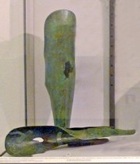
Tadinum
Cippus (4th century BC) [37]
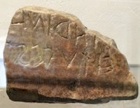
“tarina/ ei tuce st...”
According to Tiziana Capriotti (in entry 37 of the catalogue edited by L. Agostiniani , referenced below):
“In all probability, it functioned as a boundary marker for the Umbrian settlement named Tarsino- that occupied the summit of Colle I Mori” (my translation).
Alberto Calderini (in entry 37 of this catalogue) observed that:
“This inscription is of exceptional importance for a number of reasons. First and foremost, it testifies to the [name of ] the Umbrian settlement on Colle I Mori in the 4th century BC ..., and offers a direct confirmation of of the mention of [this community] in Table 1 [of the Iguvine Tables [see below)]” (my translation).
In fact, both Table I and Table VIIa describe how Serfus Martius and his associate deities were invoked against the enemies of the Iguvines during the ritual purification of the army. These enemies included:
“ totar tarsinater trifor tarsinater”
(the Tadinate community, the Tadinate territory).
Ameria
Votive inscription (late 4th century BC) [24]
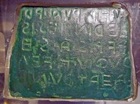
These two five-line inscriptions, which use an Etruscan alphabet from Volsinii (Orvieto), are similar but not identical, and their fragmentary nature makes them difficult to understand. A transcription (UMBR-1) is givem in the website of the Titus Project. The first line of each seems to record the dedication of a gift (“dunu”) to a deity (“duvie”), perhaps Jove or another deity associated with him. The other lines probably record the family names of the donors.
Iguvium
Iguvine Tables [17]
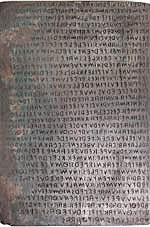
Copy of one of the Iguvine Tables
Image courtesy of the Soprintendenza per i Beni Archeologici dell' Umbria
These seven inscribed bronze tables contain what are by far the longest surviving inscriptions in any Italic language other than Latin. They are of fundamental importance for the understanding of both the Italic and the Etruscan languages, and they also provide a rare insight into ancient Umbrian culture.
The tables are of different sizes, and were inscribed at different times, probably over a period of more than a century. Five are inscribed on both sides: two (now designated as Tables III and IV) are inscribed on only one side and were probably meant to be clipped back-to-back. The tables were found together, and there is no reason to believe that they came from different locations. It is, of course, possible that there were originally more (perhaps many more) of them.
The texts of the surviving inscriptions (entitled ‘Iguvinische Tafeln’) are published as part of the Titus Project. They prescribe the liturgical practices of an association of priests known as the “fratrusper atiierie” (Atiedian Brothers) in the Umbrian settlement of Iguvina. The most important of these relate to the concerns of the whole community, but others relate more specifically to the brotherhood itself.
History of the Tables
A document in the archives of Gubbio records that Presentina, the daughter of Francesco Vici Maggi, and Angela, his wife, sold “certarum tabularum eburnearum” (certain ivory (sic) panels) to the Commune in return for two years’ proceeds from the tax on “hills and pastures” (presumably a tax levied on grazing rights). The historian Leandro Alberti, who visited Gubbio in 1530, recorded the tables in his “Descrittione di Tutta Italia” (1550). They were recorded again in the Statutes of Gubbio of 1673, with a note that they had been discovered in an underground room near the Roman theatre in 1444.
The inscriptions were brought to the attention of a wider audience in 1718, when Bishop Fabio Manciforte of Gubbio used a mechanical press to make copies and distributed them to a number of scholars. Another 110 years passed before a German scholar, Karl Otfried Müller (referenced below), first recognised that the text is in an Italic language, and that:
✴four of the tables (now designated as Tables I-IV) use an Etruscan alphabet (read from right to left);
✴two (now designated as Tables VI and VII) use the Latin alphabet (read from left to right); and
✴one (now designated as Table V) uses both:
•the inscription on Table Va and the first seven lines on Table Vb use an Etruscan alphabet; and
•the remainder of the lines on Table Vb use the Latin alphabet.
In 1833, K. Lepsius determined the value of the Umbrian signs and also suggested the convention for numbering the tables that is still used today. Two other German scholars, T. Aufrecht and A. Kirchhoff, published the first translation into Latin in 1849-51.
This early German work forms the basis of modern scholarship on the tables, although there is still considerable uncertainty about the precise meaning of the text. The work referenced below by A. Ancillotti and R. Cerri (abbreviated as A-C in this account), which is an edited version of a more comprehensive work in Italian, contains the most modern transcription of the inscriptions and a translation into English.
Dating and Function of the Tables
According to Augusto Ancillotti (2011, referenced below), epigraphic analysis suggested that the tables that use an Etruscan alphabet were inscribed at different times:
✴Tables III and IV were engraved in the late 3rd century BC;
✴Tables I and II probably date to the early 2nd century BC; and
✴Table V was inscribed in the middle of the 2nd century BC, when the Etruscan alphabet was giving way to the Latin alphabet in Italic inscriptions.
Tables VI and VII, which use the Latin alphabet, were probably cast in the early 1st century BC. (Note that Simone Sisani, referenced below, at p. 243, gave slightly different dating for Tables V-VII). The last lines of Tables I and IIa are almost identical:
“kvestretie usace svesu vuvcis ti teteies”
Lucius Tetteius, son of Titus [did it] in his quaestorship on liturgy
This suggests that Lucius Tetteius, an official of the brotherhood, arranged for the inscription of these two tables. We have no information as to the commissioning of the other tables
According to Simone Sisani (referenced below, at p. 249)
“... the corpus falls into two easily distinguishable groups ...:
-Tables I-IV ... contain a summary of rituals derived from the sacred books in the archives of the Atiedian Brothers [see below]; while
-Tables V-VII, which were intended for public display [as evidenced by holes from which they could hang], contain:
•faithful transcriptions of the rituals in these sacred books (VI and VIIa); and
•excerpts of the internal regulations of the college (V and VIIb)” (my translation).
For most of the extended period over which the inscriptions were made, Iguvina (or Iguvium, as the Romans would have called it) was a favoured ally of Rome. Yet Rome is never mentioned in the inscribed texts. What is more, at least in Tables I and VIIa, the city described in the tables had its own army and its own enemies among its neighbours (as discussed below), a situation that would not have pertained under Roman hegemony. This suggests (at least, to me) that the text was originally written the pre-Roman period, perhaps on a less expensive medium such as linen or stone.
Simone Sisani (referenced below) suggested the circumstances in which the two groups of tables were eventually inscribed on bronze:
✴“The epoch [in which Tables I-IV were inscribed], i.e. the period between the 3rd and 2nd centuries BC, ... coincides with the start of the monumentalisation of [Iguvium] using Hellenistic principles of architecture and urbanisation that were borrowed from Rome. In this context, ... the incision of these tables can be understood as representing the desire of the Iguvine aristocracy to reaffirm its unity and its role using religious traditions, in a manner that was non-confrontational with Rome. It might be said that the inscription [of Tables I-IV] monumentalised the rites in bronze in the period in which the walls, the temples and the buildings of the city were monumentalised in stone” (my translation from p. 251).
✴“Rather different is the picture presented by the more recent Tables V-VII. In evaluating their function, it is important to underline that they ... were intended for the publication of the ritual contained in the [earlier] tables ... The choice of transliterating the Umbrian text in Latin letters ... [suggests] an intention to render it accessible to a wider public ... It is possible to put forward a hypothesis for the motivation that led to this inscription in the period between the 2nd and 1st centuries BC ..., [at a time when] the agrarian reforms proposed [in Rome] threatened the economic interests of the Italian allied cities ... and destabilised the political power of local élites ... The publication in Gubbio at this time of the most important ritual texts in the city could only constitute a reaffirmation of traditional religious values that would legitimise the local ruling class. An analogous Etruscan development is, moreover, evidenced by the so-called prophecy of Vegoia, the divulgence of which can be attributed to the same period. [Here, Sisani cited William Harris, referenced below, at pp. 31-40].” (my translation from pp. 254-5).
Ethnic Identity
The people of Iguvium identified themselves as ‘totar iiovinar’. Even more particularly, they belonged originally to one of the “tekuries” (the ten tribes, clans or districts) that are named in Table II. By the time that this table was inscribed, there were in fact twenty of these divisions, but the newer ones each took one of the original ten names. (For example, the list included the Caselas; the second Caselas; and the third Caselas.) Thus, it seems that the clans belonged to a federation that we might call the Iguvine League, and that the tablets were intended to document the traditions that gave expression to their shared political and religious identity.
As touched on above, Tables I and VIIa describe how Serfus Martius and his associate deities were invoked against the enemies of Iguvina during the ritual purification of the army. These enemies are named as:
✴“totar tarsinater trifor tarsinater” (the Tadinate town, the Tadinate territory) which seems to relate to the name “tarina ..” on a boundary cippus (4th century BC) from the the slopes of Colle I Mori outside Gualdo Tadino that is described above;
✴“tuscer [nomner]” (the Etruscan name);
✴“naharcer [nomner]” (the Narcan name), perhaps the inhabitants of the valley of the Nar (Nera), near modern Narni and Terni; and
✴“iabuscer nomner” (the Iapudic name).
Since the first three enemies probably lived (respectively) on or beyond the eastern, western and southern boundaries of Iguvina, it might be conjectured that the people of the Iapudic name lived on or beyond its northern border.
The primary Etruscan enemies are likely to have been the people of Perusia, the nearest Etruscan settlement to Iguvina. However, they are not differentiated from the wider ethnic identity, ‘Etruscan’. By contrast, wide ethnic identities such as ‘Umbrian’ or ‘Sabine’ are not given to Iguvina itself, nor to its Italic enemies.
Content
Ritual Purification
The longest continuous part of the text, which is on Tables VI and VIIa, provides a detailed account of a ritual or series of rituals for the purification of three distinct entities:
✴“ukriper fisiu” or “okriper fisiu” (for the Fisian Mount - see below);
✴ “tutaper Iguvina” or “totaper iiouina” (for the settlement of Iguvina, the earliest known name for Roman Iguvium, today’s Gubbio); and
✴“pupluper tutas iiuvinas” or “popluper totar iiuvinar” (for the army of Iguvina). This is sometimes given as, “for the people of Iguvina”. However, following A -C, I assume that it is the army that is being purified, not least because the gods invoked in this part of the ritual were mostly associates of Mars (see below).
At the start of these purification rituals, the augur (see below) took the auspices by observing the flight of prescribed species bird. Once the auspices were good, the “officiant” (see below) led a procession around the city walls and around the assembled soldiers. These processions were punctuated by carefully prescribed prayers and sacrifices to specified Gods at specified locations.
Table I provides a shorter version of a very similar ceremony. Although it was inscribed before Tables VI and VIIa (since it uses an older alphabet), A-C believe that the ritual that it describes was a later version of that on the other two tables.
Fisian Mount
The “ukar fisiu” (Fisian Mount), which was ritually purified in the ceremony above, seems to have been the sanctuary of Iguvina. The name of this mountain is related to Fisius Sancius, the god of “good faith” who was invoked inside the Tesenacan Gate during the purification of Iguvina (see below). This suggests that the main temple on the mountain was dedicated to this deity. Table Va states that the regular meetings of the brotherhood were held:
“... in the Atiedian meeting place on the holy mount, in the Atiedian sanctuaries”.
The route prescribed for the procession during the ceremony for the purification of the Fisian Mount seems to closely follow the city walls, suggesting that the “mount” itself was within them. If so, then the elevated site of the present Duomo seems to be the obvious place to locate it. However, the remains of ancient cult sites have been found on Monte Ingino (the present site of the church of Sant’ Ubaldo) and on nearby Monte Ansciano, and either of these could have been Fisian Mount. (Some scholars have suggested that it might have been the on site of the temple of Jupiter Apenninus, which is documented near the Gorge of Bottaccione, 4 km north east of Gubbio on the road to Scheggia.)
Other Ceremonies and Sacrifices
Tables III and IV are physically similar to each other and smaller that the other tables. They prescribe a set of instructions for the annual rites devoted to the deities Puemun and Vesuna. This was held at noon on “sestentasiaru urnasiaru” (at the none of a month called urnasiaru). Michael Weiss (referenced below) suggests was at the start of the year.
Table IIb prescribes the rituals for the annual assemblies of the “tekuries” (the ten subdivisions of the people of Iguvina). It involved a number of sacrifices, including one made specifically for the gens Vovicia (also given as Vucia or Lucia). The things sacrificed included unblemished animals and also:
“... the produce of the land .... either with flour or with wine”.
Table IIa describes:
✴the sacrifices made in the event of adverse auspices; and
✴the sacrifice made for the gens Petronia during the feast of Hondus Jovius (see below).
Administration
Table V seems to be a list of decrees emanating from meetings of the brotherhood that were dated by reference to the year of the “uhteretie” (magistracy) of:
✴“t t kastruciie” (Titus Castricius, son of Titus); and then
✴“k t kluviier” (Caius Cluvius, son of Titus).
(This use as a dating device suggests that the uhter was a magistrate of Iguvina rather than an official of the brotherhood).
The four lines on Table VIIb record the decree that mandated that the “fratrexs” (brother superior) should supply the heifers that were let loose towards the end of the ritual purification of the army (see below). If he did not do so, he faced a fine of 300 asses (small bronze coins).
Atiedian Brothers
The names of the “tekuries” of Iguvina listed in Table II seem to relate to specific families and/or districts of the city. The list starts with the “atiieriate”, a name that is clearly associated with the “fratrusper atiierie” (Atiedian Brothers). This suggests that the brotherhood was named for a district of Iguvina and/or for one of its prominent families.
[William P. Thayer has kindly drawn my attention to an inscription embedded in the facade of the Casa dei Canonici, Assisi that commemorates the dead wife of a man who had been freed by a lady from the gens Atiedia.]
Two rituals described in the tables involved sacrifices that were made specifically for brotherhood:
✴those of “sestentasiaru urnasiaru” (Tables III and IV); and
✴those carried out in the event of adverse auguries (Table IIa).
The “uhter” of Iguvina attended the first of these ceremonies. Mention is also made in this ritual of:
“... the quinary unit elected among the Brethren”:
this body presumably comprised their elected senior officials.
Four specific officials are mentioned in the tables:
✴ two who are associated with the purification rituals:
•the “arsfertur” or “arfertur” (translated in A-C as the “officiant”), the important official who presided over the rituals described in all of the tables: and
•“poei angla aseriato eest” (he who goes to observe the messengers - i.e. the augur), who took the auspices at the start of the ritual purification of Iguvina (Table VIa) and its army (Table VIb); and
✴two who seem to be largely concerned with administration:
•the “fratreks” or “fratrexs” (brother superior), who appears in Tables Va, Vb and VIIb; and
•the kvestur, who also appears in Tables Va and b. He polled the celebrants at a ritual dinner to see if had been correctly provided and, if it had not, polled them again to determine by how much the “arfertur” should be fined. (This title might relate to the Roman “quaestor”, which literally means the “man who asks questions”). As noted above, one of these quaestors, Lucius Tetteius, son of Titus, seems to have arranged for the inscription of Tables I and IIa during his “quaestorship on liturgy”.
Table Vb also refers to the “homons dur puri far eiscurent” (two men who come to fetch the flour) for the sacrifice at the annual assemblies:
✴These two men are probably analogous to the “cvestur farariur” (quaestors responsible for spelt or flour) in the inscription (ca. 100 BC) on the sundial from Mevania (see Walk II, Detour B, Bevagna), which is now in the Museo Archeologico, Perugia.
✴The flour came from:
-the Ager Tltius of Picus Martius, which belonged to the Clavernii; and
-the Ager Casilus of Picus Martius.
These fields may have been reserved for flour destined for ritual use. This would be analogous to the sacred field (ager .... sacre stahu) recorded in an inscription from Bastia. (This inscription is in the Museo Archeologico Nazionale, Perugia, and there is a plaster cast of it in the Museo Civico, Assisi).
(The inscriptions from Bevagna and Assisi are also described in the page on Italic Inscriptions after 295BC).
Gods of Iguvina
Grabovius Triad
Like other Italic people, the people of Iguvina venerated the deities that the Romans called Jupiter (chief of the gods) and Mars (the god of war). Each of these, together with the otherwise unknown Vofionus, appears in the tables with the epithet “krapuvi” (Grabovius). Thus, in the procession around the walls during the purification of Iguvina, three oxen were sacrificed to each of:
✴Jupiter Grabovius, outside the Trebulan Gate;
✴Mars Grabovius, outside the Tesenacan Gate; and
✴Vofionus Grabovius, outside the Veian Gate.
Jupiter and Mars appeared in the pantheon of ancient Rome together with Quirinus, an ancient deity of possibly Sabine origin: it might be that Vofionus was a local version of the Roman Quirinus.
Other Aspects of Jupiter
Three deities who can be related to Jupiter were also invoked during this procession around the walls of Iguvina:
✴Trebus Iovius, inside the Trebulan Gate;
✴Fisovius or Fisius Sancius (who seems to be associated with the Sabine Semo Sancus and the Roman Dius Fidius, an aspect of Jupiter as the patron of “good faith”), inside the Tesenacan Gate; and
✴Tefrus Iovius, inside the Veian Gate.
Jupiter and his associates were also invoked in other rituals:
✴A specific ritual is described for the feast of Hondius Iovius, in which an unblemished young dog was sacrificed to this deity for the gens Petronia (Table IIa).
✴Sacrifices were made to Jupiter and Jupiter Sancius during assemblies of the “tekuries”, one of which was specifically for the the gens Vovicia (Table IIb).
✴Torsa Iovia was invoked during the ritual purification of the army. A number of heifers were let loose in the town during the ritual, and the first three to be caught were sacrificed to her (Table VIIa).
See also Vesticius Sancius, Dicamnus Iovius and Ahtus Iovius below.
Serfus Martius
In Table VIb, a triad was also invoked against the enemies of Iguvina (whose ethnic identities are discussed below):
✴Serfus (or Cerfus) Martius, who seems to be a specific aspect of Mars; and
✴what seem to be two female consorts:
•Prestata Serfia of Serfus Martius; and
•Torsa Serfis of Serfus Martius.
These deities were implored:
“Terrify them and cause them to tremble, defeat and ruin them, kill and annihilate them, wound and ulcerate them, shackle and fetter them.”
In the ritual purification of the army described in Table VII, the same triad of deities was invoked:
✴three boars were sacrificed to Serfus Martius at “Fontuli” (perhaps Fontevole, the location of an ancient necropolis near Gubbio);
✴three sows were sacrificed to Prestata Serfia of Serfus Martius at “Rubinia”; and
✴three heifers were sacrificed to Torsa Serfis of Serfus Martius at a place “beyond the Sata river”.
Before this purification of the army, on the first occasions on which the army is specifically mentioned during ritual for the purification of Iguvina itself (also in Table VIb), two apparently related deities were invoked:
✴Mars Horius, to whom three young bulls are sacrificed at the Grove of Jupiter: and
✴Hondus Serfius, to whom another three young bulls are sacrificed at the Grove of Coredius.
See also Ahtus Martius below.
Gods Invoked for the Atiedian Brothers
The invocations made during of “sestentasiaru urnasiaru” (Table III-IV) were:
“... for the Atiedian Brothers, for the acts related to the sacred places, for Iguvina, for the territory of Iguvina”.
“Father Jupiter” was the first god to be invoked during this ritual. However, the most prominent deities invoked in it were two that are not mentioned elsewhere in the tables:
✴“puemune puprike”; and
✴“vesune puemunes puprices”, his consort.
Michael Weiss (referenced below) suggests that “puemune puprike” can be translate as “the god who goes in circles, implying that this divinity presided over the yearly cycle. He also suggests that his consort, Vesuna (like the Etruscan goddess Nortia) was goddess of fate, and in particular for determining the fate of communities for the new year.
Sacrifices were also made for the Atiedian Brothers during the ritual used to reverse the consequences of adverse auguries (Table IIa). These sacrifices were made:
✴to Jupiter;
✴to three of his associates:
•Vesticius Sancius;
•Dicamnus Iovius; and
•Ahtus Iovius; and
✴to two other deities:
•“speture” (Spector); and
•Ahtus Martius.
Read more:
L. Agostiniani et al. (Eds), “Screhto Est: Lingua e Scrittura degli Antichi Umbri”, (2011) Città di Castello
A. Ancillotti, “Le Tavole Iguvine”, in
L. Agostiniani et al. (Eds), “Screhto Est: Lingua e Scrittura degli Antichi Umbri”, (2011) Città di Castello, at p.22
M. Weiss, “Language and Ritual in Sabellic Italy: The Ritual Complex of the Third and Fourth Tabulae Iguvinae”, (2010) Leiden
S. Sisani, “Tuta Iguvina: Sviluppo e Ideologia della Forma Urbana a Gubbio”, (2001) Rome
G. Bradley, "Ancient Umbria", (2000) Oxford, particularly Appendix II
A. Ancillotti and R. Cerri, "The Tables of Iguvium", Perugia (1997)
G. Rocca, "Iscrizioni Umbre Minori", (1996) Florence
A. Ancillotti, "Tavole Iguvine", in
M. Matteini Chiari (Ed.), “Museo Comunale di Gubbio: Materiali Archeologici”, (1995) Perugia, pp 39-86
J. Wilkins, in Section 5.2 of:
C. Malone and S. Stoddart (Eds.), "Territory, Time and State", Cambridge (1994)
K. Müller, “Die Etrusker”, (1828) Breslau
See also the website of Carlo d’Adamo and the links therein.
Key to Ancient Umbria: Home Site Map: Umbrians
Umbria before the Roman Conquest
Umbrian Inscriptions before 310/9 BC Goddess Cupra in Umbria and Picenum